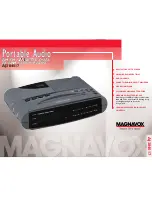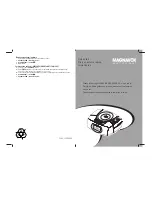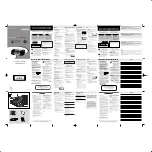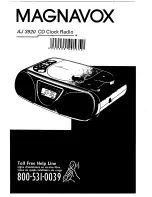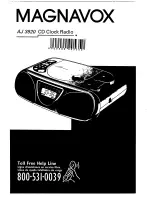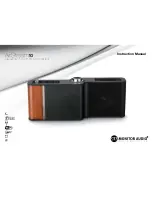
DESCRIPTION
The Ericsson GE UHF MDX
Mobile Radio is a synthe-
sized, wide band radio that uses integrated circuits and micro-
computer technology to provide high performance in
conventional communications systems. The UHF MDX Mo-
bile radio provides 40 Watts of RF power output in the 403-
440, 440-470 or 470-512 MHz bands.
This radio operates in the conventional mode and can oper-
ate with tone Channel Guard, Digital Channel Guard, or carrier
squelch, depending on personality programming. The Channel
Guard range is 67.0 to 210.7 Hz. Squelch Tail Elimination
(STE) is used with Channel Guard to eliminate squelch tails at
the receiving radio by phase shifting the transmitted Channel
Guard tone when the Push-To-Talk (PTT) switch is released.
All radio functions are stored in a programmable Electri-
cally Erasable PROM (EEPROM).
•
Serial Programming Interface Module
TQ3370
•
Programming Cable (19B801417P10)
TQ3372
•
MDX Series Programming Software
TQ3346
With the interface equipment and software, the computer
can be used to program (or re-program) customer system fre-
quencies, Channel Guard tones and options. Selection of op-
tions is done during radio initialization using the PC
programmer.
The UHF MDX Mobile Radio assembly contains the fol-
lowing circuit boards and assemblies:
•
Power Amplifier
19D904792
•
RF Board
188D5062
•
System Board
19D901891
•
Audio/Logic Board
19D903963
•
Audio Amplifier Board
19D904025
•
Front Cap Assembly
19D904151
The circuit boards are all mounted on a main casting to pro-
vide easy access for servicing. Interconnect plugs are used to
connect the boards to eliminate pinched wires and other wiring
problems.
RF BOARD
The RF Board includes the programmable frequency syn-
thesizer, transmitter exciter, receiver front-end and Intermedi-
ate Frequency (IF) circuitry.
Synthesizer
The synthesizer circuit generates all transmit and receive
RF frequencies. The synthesizer frequency is controlled by the
microprocessor located on the Audio/Logic Board. Frequency
stability is maintained by a temperature compensated reference
oscillator module. Transmit audio is processed on the
Audio/Logic Board and applied to the synthesizer to modulate
the Voltage Controlled Oscillator (VCO) and the Temperature
Controlled Xtal (crystal) Oscillator (TCXO). The buffered
VCO output drives both the transmitter exciter and the receiver
mixer.
Transmitter
The transmitter consists of a fixed-tuned exciter module,
PA module and a power control circuit. The PA module pro-
vides RF output to drive the antenna. The power control circuit
controls the PA module to maintain constant output power
across the band. The RF output level is internally adjustable for
rated power. A thermistor control circuit protects the PA from
overheating by linearly reducing the power output level with
increasing temperature.
Receiver
The dual conversion receiver circuit consists of a front-end
section, 45 MHz first IF, a 455 kHz second IF and Frequency
Modulation (FM) detector. All audio processing and squelch
functions are accomplished on the Audio/Logic Board.
POWER AMPLIFIER BOARD
The PA Board amplifies the RF board output, then connects
it back to the RF board where it is coupled through a PIN di-
ode antenna switch, a low-pass filter and a directional coupler
to provide 40 watts power output at the antenna connector.
AUDIO/LOGIC BOARD
The Audio/Logic Board provides all audio and digital proc-
essing of the receive and transmit audio for digital processing
by the Logic Board. This board also contains audio filtering,
conventional analog tone processing and the receiver squelch.
The Audio/Logic Board controls the operation of the radio and
digitally processes the receiver and transmit audio. The board
contains a microprocessor and associated memory circuits in-
cluding an Electrically Programmable Read Only Memory
(EPROM) for controlling the processor and a programmable
"personality" memory, an EEPROM to store customer fre-
quencies, tones and options. The microprocessor provides con-
trol data to the Audio Signal Processor (ASP) conventional
tone generation and detection, frequency data for the synthe-
sizer and sends and receives data to/from another microproc-
essor on the Display Board for the alphanumeric LED dis-
play.
FRONT CAP ASSEMBLY
The Front Cap Assembly contains the Audio Amplifier
Board. This board provides audio compression for the re-
ceived audio in the discriminator internal/external speaker
audio paths. A 10-watt power amplifier is provided on the
board to drive a 4-ohm external speaker or the 8-ohm inter-
nal speaker.
SYSTEM BOARD
The system board controls the main input power to the
radio. The IGNITION SENSE input lead provides the nec-
essary signals to the MOSFET switching circuit. The board
also interfaces all option connections from the internal
boards in the radio with the optional items outside of the ra-
dio. All external options for the radio, interconnect to the
System Board through the back of the radio using an op-
tional cable.
ACCESSORIES AND OPTIONS
PC PROGRAMMER OPTIONS
The radio is programmed using an IBM compatible Per-
sonal Computer (PC) equipped with an RS-232 serial inter-
face unit and the cable between the PC and the unit. An
auxiliary power supply for the unit is also included but is not
needed to program the radio.
Option TQ3372 provides the MDX UHF radio program-
ming cable between the PC interface unit and the radio mi-
crophone jack.
PC PROGRAMMED OPTIONS
Carrier Control Timer (CCT)
The Carrier Control Timer turns off the transmitter after
the microphone PTT switch has been keyed for a pre-pro-
grammed time period. A pulsing alert tone warns the opera-
tor to unkey and then key again the PTT to continue the
transmission. The timer can be programmed, using the PC
programmer. Any time period between 0 seconds and 4.1
minutes can be programmed in 10 second increments. The
timer can be enabled or disabled for each channel.
Channel Guard
Channel Guard provides a means of restricting calls to
specified radios through the use of a Continuous Tone Coded
Squelch System (CTCSS), or a Continuous Digital Coded
Squelch System (CDCSS). Tone frequencies range from
67.0 Hz to 210.7 Hz in 0.1 Hz steps. There are 83 standard
PC programmable digital codes. The Channel Guard tone
frequencies and codes are software programmable. Both
tone frequencies and digital codes may be used. These codes
and frequencies are listed in Table 1- Channel Guard Tone
Frequencies and Table 2- Digital Channel Guard Codes.
Table 1 - Standard Channel Guard Tone Frequencies (Hz)
67.0
71.9
74.4
77.0
79.7
82.5
85.4
88.5
91.5
94.8
97.4
100.0
103.5
107.2
110.9
114.8
118.8
123.0
127.3
131.8
136.5
141.3
146.2
151.4
156.7
162.2
167.9
173.8
179.9
186.2
192.8
203.5
210.7
1. Do not use 179.9 Hz or 118.8 Hz in areas served by 60 Hz power distribution systems (or 100.0 Hz or 151.4 Hz in areas supplied with 50Hz power).
Hum modulation of co-channel stations may "false" Channel Guard decoders.
2. Do not use adjacent Channel Guard tone frequencies in systems employing multiple Channel Guard tones. Avoid same-areas co-channel use of adjacent
Channel Guard tones whenever possible. As stated in EIA Standard RS-220, there is a possibility of decoder falsing.
3. To minimize receiver turn-on time delay, especially in system using Channel Guard repeaters or receiver voting, choose the highest usable Channel
Guard tone frequency. Do not use tones below 100 Hz when it is necessary to meet the receiver response time requirements of EIA Standard RS-220.
To reverse the polarity of the digital Channel Guard
codes, in the PC programmer, type I (inverted) be-
fore the code number, i.e. I023.)
NOTE
LBI-39014A
3
Содержание MDX LBI-39014A
Страница 12: ...ASSEMBLY DIAGRAM MDX UHF Mobile Radio 19D904183 Sh 5 Rev 18 LBI 39014A 11 ...
Страница 13: ...ASSEMBLY DIAGRAM MDX UHF Mobile Radio 19D904183 Sh 7 Rev 18 LBI 39014A 12 ...
Страница 14: ...INTERCONNECTION DIAGRAM MDX UHF Mobile Radio 188D5198 Sh 1 Rev 0 LBI 39014A 13 ...
Страница 15: ...INTERCONNECTION DIAGRAM MDX UHF Mobile Radio 188D5198 Sh 3 Rev 0 LBI 39014A 14 ...
Страница 16: ...INTERCONNECTION DIAGRAM MDX UHF Mobile Radio 188D5198 Sh 4 Rev 0 LBI 39014A 15 ...

















